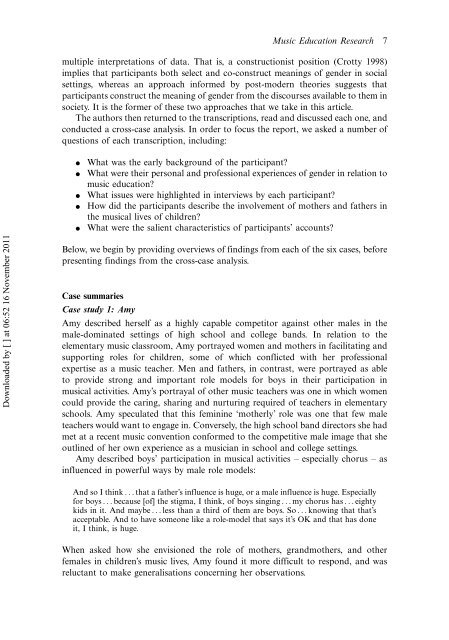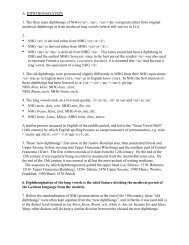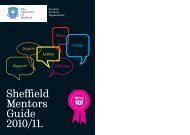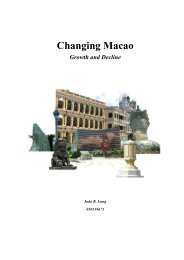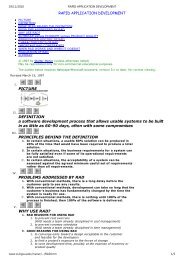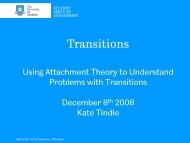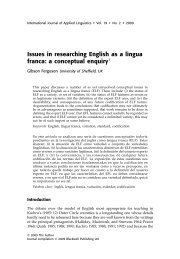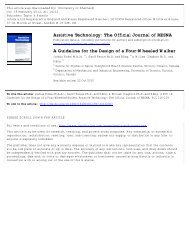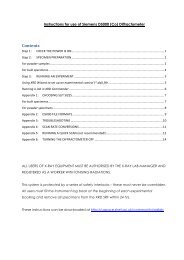Music teachers' constructions of gender in elementary education
Music teachers' constructions of gender in elementary education
Music teachers' constructions of gender in elementary education
You also want an ePaper? Increase the reach of your titles
YUMPU automatically turns print PDFs into web optimized ePapers that Google loves.
Downloaded by [ ] at 06:52 16 November 2011<br />
<strong>Music</strong> Education Research 7<br />
multiple <strong>in</strong>terpretations <strong>of</strong> data. That is, a constructionist position (Crotty 1998)<br />
implies that participants both select and co-construct mean<strong>in</strong>gs <strong>of</strong> <strong>gender</strong> <strong>in</strong> social<br />
sett<strong>in</strong>gs, whereas an approach <strong>in</strong>formed by post-modern theories suggests that<br />
participants construct the mean<strong>in</strong>g <strong>of</strong> <strong>gender</strong> from the discourses available to them <strong>in</strong><br />
society. It is the former <strong>of</strong> these two approaches that we take <strong>in</strong> this article.<br />
The authors then returned to the transcriptions, read and discussed each one, and<br />
conducted a cross-case analysis. In order to focus the report, we asked a number <strong>of</strong><br />
questions <strong>of</strong> each transcription, <strong>in</strong>clud<strong>in</strong>g:<br />
“ What was the early background <strong>of</strong> the participant?<br />
“ What were their personal and pr<strong>of</strong>essional experiences <strong>of</strong> <strong>gender</strong> <strong>in</strong> relation to<br />
music <strong>education</strong>?<br />
“ What issues were highlighted <strong>in</strong> <strong>in</strong>terviews by each participant?<br />
“ How did the participants describe the <strong>in</strong>volvement <strong>of</strong> mothers and fathers <strong>in</strong><br />
the musical lives <strong>of</strong> children?<br />
“ What were the salient characteristics <strong>of</strong> participants’ accounts?<br />
Below, we beg<strong>in</strong> by provid<strong>in</strong>g overviews <strong>of</strong> f<strong>in</strong>d<strong>in</strong>gs from each <strong>of</strong> the six cases, before<br />
present<strong>in</strong>g f<strong>in</strong>d<strong>in</strong>gs from the cross-case analysis.<br />
Case summaries<br />
Case study 1: Amy<br />
Amy described herself as a highly capable competitor aga<strong>in</strong>st other males <strong>in</strong> the<br />
male-dom<strong>in</strong>ated sett<strong>in</strong>gs <strong>of</strong> high school and college bands. In relation to the<br />
<strong>elementary</strong> music classroom, Amy portrayed women and mothers <strong>in</strong> facilitat<strong>in</strong>g and<br />
support<strong>in</strong>g roles for children, some <strong>of</strong> which conflicted with her pr<strong>of</strong>essional<br />
expertise as a music teacher. Men and fathers, <strong>in</strong> contrast, were portrayed as able<br />
to provide strong and important role models for boys <strong>in</strong> their participation <strong>in</strong><br />
musical activities. Amy’s portrayal <strong>of</strong> other music teachers was one <strong>in</strong> which women<br />
could provide the car<strong>in</strong>g, shar<strong>in</strong>g and nurtur<strong>in</strong>g required <strong>of</strong> teachers <strong>in</strong> <strong>elementary</strong><br />
schools. Amy speculated that this fem<strong>in</strong><strong>in</strong>e ‘motherly’ role was one that few male<br />
teachers would want to engage <strong>in</strong>. Conversely, the high school band directors she had<br />
met at a recent music convention conformed to the competitive male image that she<br />
outl<strong>in</strong>ed <strong>of</strong> her own experience as a musician <strong>in</strong> school and college sett<strong>in</strong>gs.<br />
Amy described boys’ participation <strong>in</strong> musical activities especially chorus as<br />
<strong>in</strong>fluenced <strong>in</strong> powerful ways by male role models:<br />
And so I th<strong>in</strong>k ...that a father’s <strong>in</strong>fluence is huge, or a male <strong>in</strong>fluence is huge. Especially<br />
for boys ...because [<strong>of</strong>] the stigma, I th<strong>in</strong>k, <strong>of</strong> boys s<strong>in</strong>g<strong>in</strong>g ...my chorus has ...eighty<br />
kids <strong>in</strong> it. And maybe ...less than a third <strong>of</strong> them are boys. So ...know<strong>in</strong>g that that’s<br />
acceptable. And to have someone like a role-model that says it’s OK and that has done<br />
it, I th<strong>in</strong>k, is huge.<br />
When asked how she envisioned the role <strong>of</strong> mothers, grandmothers, and other<br />
females <strong>in</strong> children’s music lives, Amy found it more difficult to respond, and was<br />
reluctant to make generalisations concern<strong>in</strong>g her observations.


